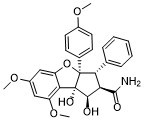Didesmethylrocaglamide
This product is for research use only, not for human use. We do not sell to patients.

For small sizes, please check our retail website as below: www.invivochem.com
| Size | Price | Stock |
|---|---|---|
| 100mg | $2550 | Check With Us |
| 200mg | $3825 | Check With Us |
| 500mg | $6455 | Check With Us |
Cat #: V37649 CAS #: 177262-30-5 Purity ≥ 99%
Description: Didesmethylrocaglamide is a naturally occurring rocaglamide type of 1H-cyclopenta[b]benzofuran lignans isolated from three Aglaia species (Aglaia duperreana, A. oligophylla and A. spectabilis).
Top Publications Citing Invivochem Products
Publications Citing InvivoChem Products
Product Promise

- Physicochemical and Storage Information
- Protocol
- Related Biological Data
- Stock Solution Preparation
- Quality Control Documentation
| Molecular Weight (MW) | 477.51 |
|---|---|
| Molecular Formula | C27H27NO7 |
| CAS No. | 177262-30-5 |
| SMILES Code | O=C([C@H]([C@H]1C2=CC=CC=C2)[C@@H](O)[C@]3(O)[C@@]1(C4=CC=C(OC)C=C4)OC5=CC(OC)=CC(OC)=C35)N |
| Synonyms | Didesmethylrocaglamide; DDR; rocaglamide-derivative. |
| Protocol | In Vitro | Didesmethylrocaglamide induces apoptosis in both neurofibromatosis type 1 (NF1)-expressing and NF1-deficient MPNST cells, possibly subsequent to the activation of the DNA damage response. Didesmethylrocaglamide-treated sarcoma cells show decreased levels of multiple oncogenic kinases, including insulin-like growth factor-1 receptor. Didesmethylrocaglamide inhibits MPNST cell proliferation by inducing cell cycle arrest at G2/M and subsequently, cell death. Didesmethylrocaglamide-treated 697-R cells exhibits IC50 values is very similar to those of parental 697 cells (4 vs 3nM of IC50, respectively). Didesmethylrocaglamide (5 nM, and 10 nM; 72 hours; MPNST cells) treatment arrests MPNST cells at G2-M, increases the sub-G1 population, induces cleavage of caspases and PARP, and elevates the levels of the DNA-damage response marker γH2A.X, while decreasing the expression of AKT and ERK1/2. |
|---|
These protocols are for reference only. InvivoChem does not
independently validate these methods.
| Solvent volume to be added | Mass (the weight of a compound) | |||
|---|---|---|---|---|
| Mother liquor concentration | 1mg | 5mg | 10mg | 20mg |
| 1mM | 2.0942 mL | 10.4710 mL | 20.9420 mL | 41.8839 mL |
| 5mM | 0.4188 mL | 2.0942 mL | 4.1884 mL | 8.3768 mL |
| 10mM | 0.2094 mL | 1.0471 mL | 2.0942 mL | 4.1884 mL |
| 20mM | 0.1047 mL | 0.5235 mL | 1.0471 mL | 2.0942 mL |
The molarity calculator equation
Mass(g) = Concentration(mol/L) × Volume(L) × Molecular Weight(g/mol)
Mass
=
Concentration
×
Volume
×
Molecular Weight*
The dilution calculator equation
Concentration(start)
×
Volume(start)
=
Concentration(final)
×
Volume(final)
This equation is commonly abbreviated as: C1 V1 = C2 V2
Concentration(start)
C1
×
Volume(start)
V1
=
Concentration(final)
C2
×
Volume(final)
V2
Step One: Enter information below
Dosage mg/kg
Average weight of animals g
Dosing volume per animal µL
Number of animals
Step Two: Enter the in vivo formulation
%DMSO
+
%
+
%Tween 80
+
%ddH2O
Calculation Results:
Working concentration:
mg/ml;
Method for preparing DMSO master liquid:
mg
drug pre-dissolved in
µL
DMSO(Master liquid concentration
mg/mL)
,Please contact us first if the concentration exceeds the DMSO solubility of the batch of drug.
Method for preparing in vivo formulation:
Take
µL
DMSO master liquid, next add
µL
PEG300, mix and clarify, next add
µL
Tween 80,mix and clarify, next add
µL
ddH2O,mix and clarify.
Note:
- (1) Please be sure that the solution is clear before the addition of next solvent. Dissolution methods like vortex, ultrasound or warming and heat may be used to aid dissolving.
- (2) Be sure to add the solvent(s) in order.




































